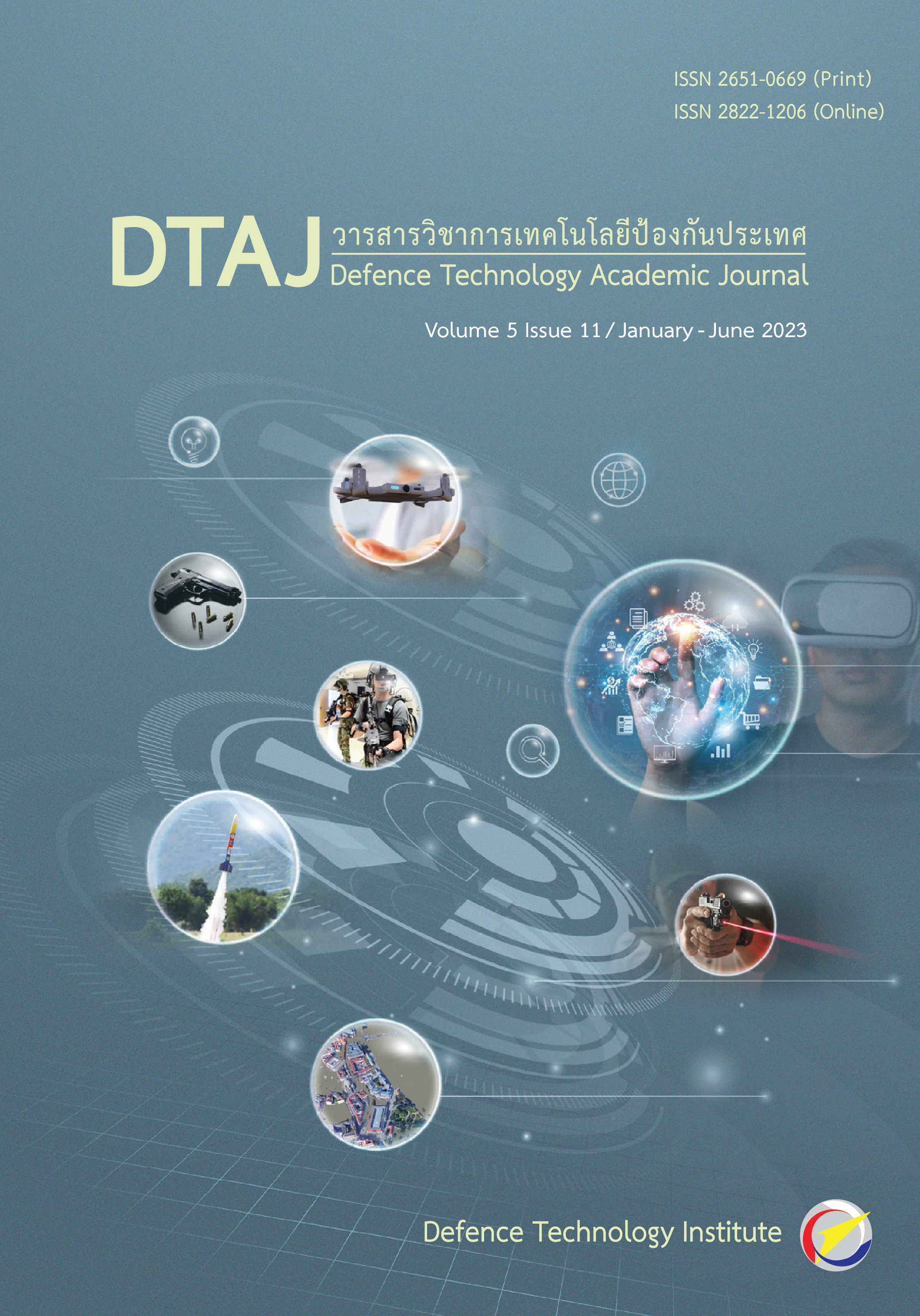Research and Development of a Laser Kit for Tactical Training Rifle
Main Article Content
Abstract
This article describes the design and development of a gun laser which is used to simulate the behavior of a bullet, both the trajectory and the bullet point, of the M4A1 tactical firearm in a virtual shooting range. This gun laser emits the infrared signal when it is turned on. The IR camera, then, captured and analyzed with the image processing before visualize the bullet point on the screen. There are 2 types of data from the sensors that are used to trigger the laser. The data from 6-AXIS-IMU-UNITMPU6886 sensor is obtained when the accelerator sensor measures the recoil force of the gun. Another data set is from SPM1423HM4H sensor which is a sound sensor for detecting the sound of the gun. These sets of data are analyzed with the microcontroller equipped with IC ESP32 chip. Artificial Intelligence (AI) in terms of Neural Network (NN) is implemented to predict if it is a gunshot so as to turn on the laser. The result from the experiment with 15 M4A1 tactical firearms in a virtual shooting range shows that the sensor is capable to detect the gunshot with the accuracy of 95.63%
Downloads
Article Details

This work is licensed under a Creative Commons Attribution-NonCommercial-NoDerivatives 4.0 International License.
Journal of TCI is licensed under a Creative Commons Attribution-NonCommercial-NoDerivatives 4.0 International (CC BY-NC-ND 4.0) licence, unless otherwise stated. Please read our Policies page for more information...
References
A. Lele, “Virtual Reality and Its Military Utility,” J. Ambient Intell. Humaniz. Comput., vol. 4, no. 1, Feb. 2011, doi: 10.1007/s12652-011-0052-4.
R. Lovreglio, D.-C. Ngassa, A. Rahouti, D. Paes, Z. Feng, and A. Shipman, “Prototyping and Testing a Virtual Reality Counterterrorism Serious Game for Active Shooting,” Int. J. Disaster Risk Reduct., vol. 82, Nov. 2022, doi: 10.1016/j.ijdrr.2022.103283.
R. Lovreglio, X. Duan, A. Rahouti, R. Phipps, and D. Nilsson, “Comparing the Effectiveness of Fire Extinguisher Virtual Reality and Video Training,” Virtu al Reality, vol. 25, pp. 133 - 145, 2021, doi: 10.1007/s10055-020-00447-5.
R. Sacks, A. Perlman, and R. Barak, “Construction Safety Training Using Immersive Virtual Reality,” Constr. Manag. Econ., vol. 31, no. 9, pp. 1005 - 1017, Sep. 2013, doi: 10.1080/01446193.2013.828844.
J. Stevens, S. C. Mondesire, C. S. Maraj, K. A. Badillo-Urquiola, and D. B. Maxwell, “Workload Analysis of Virtual World Simulation for Military Training,” in MODSIM World 2016, Virginia Beach, VA, USA, Apr. 2016, pp. 1 - 11.
D. E. Goldberg and J. H. Holland, “Genetic Algorithms and Machine Learning,” Mach. Learn., vol. 3, pp. 95 - 99, Oct. 1988, doi: 10.1023/A:1022602019183.
T. W. Edgar and D. O. Manz, “Chapter 6 -Machine Learning,” in Research Methods for Cyber Security. Cambridge, MA, USA: Syngress, 2017, pp. 153-173.
D. A. Heger, “An Introduction to Artificial Neural Networks (ANN) - Methods, Abstraction, and Usage,” 2015.
S. W. Lee et al., “A Study on Deep Learning Application of Vibration Data and Visualization of Defects for Predictive Maintenance of Gravity Acceleration Equipment,” Appl. Sci., vol. 11, no. 4, Feb. 2021, doi: 10.3390/app11041564.
P. Gaurang, A. Ganatra, Y. P. Kosta, and D. Panchal, “Behaviour Analysis of Multilayer Perceptronswith Multiple Hidden Neurons and Hidden Layers,” Int. J. Comput. Theory Eng., vol. 3, no. 2, pp. 332-337, Jan. 2011, doi: 10.7763/ IJCTE.2011.V3.328.
J. Brownlee. “Deep Learning Performance.” MACHINELEARNINGMASTERY.com. https://machinelearningmastery.com/ how-to-fix-vanishing-gradients-using-the -rectified-linear-activation-function (accessed Oct. 14, 2022).
ช. กิตตินราดร. “Machine Learning and Full-stack Python.” GOUPAI.GITHUB.io. https://guopai.github.io/index.html (accessed Oct. 3, 2022).
P. H. Winston, Artificial Intelligence, 3rd ed. USA: Addison-Wesley Pub. Co., 1992, pp. 737.
T. Wood. “Sigmoid Function.” DEEPAI.org. https://deepai.org/machine-learning -glossary-and-terms/sigmoid-function (accessed Nov. 7, 2022).
S. Visa, B. Ramsay, A. Ralescu, and E. van der Knaap, “Confusion Matrix-based Feature Selection,” in Proc. 22nd Midwest Artif. Intell. Cogn. Sci. Conf. 2011, Cincinnati, OH, USA, 2011, pp. 120 - 127.
K. K. Al-jabery, T. Obafemi-Ajayi, G. R. Olbricht, and D. C. Wunsch II, “9 -Data Analysis and Machine Learning Tools in MATLAB and Python,” in Computational Learning Approaches to Data Analytics in Biomedical Applications, London, UK: Academic Press, 2020, pp. 231-290.
Espressif Systems (Shanghai) Co., ESP32 Series Datasheet. 2022.


